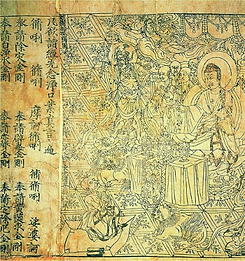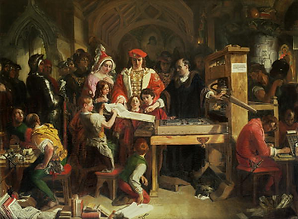Blasts From The Past - The Early Printers
As with all ancient inventions, there are conflicting views as to who was first - and printing is no exception.
Images of the Buddha were reported to have been impressed on silk or paper as far back as 670. This was recorded by a Chinese monk after his visit to India. The next recorded instance, of printed charms, was in Korea at the Pulguska Temple, between 704 and 751. Woodblock printing was first used by the Japanese in 764, for further Buddhist Charms or prayer sheets. The oldest known printed book, using the woodblock system, is known as the Diamond Sutra Roll. This sixteen foot long scroll was found by Sir Aurel Stein in 1900 and is now housed in the British Museum. It was discovered in a cave in Tun Huang, China, and was dated May 16th 868. Printed playing cards made their appearance in 969. Despite the time taken to carve the wooden printing blocks some mammoth jobs were undertaken. Between 971 - 983, Chinese printers went on to produce the Tipitaka - a Buddhist Canon - which required some 130,000 wooden blocks.
The Chinese are generally credited with the next major breakthrough - moveable type. The inventor, Pi Sheng, made moveable type of earthenware circa 1045. It could be argued that China's greatest contribution to the world of printing was the introduction of paper. This process - credited to a Chinese Court Official, Tsai Lun, circa 105 - was a jealously guarded secret, kept from the west for more than a thousand years. An early example of secrecy being used to protect a technological advantage. Moveable type continued to be developed, with the introduction of metal type in Korea in 1241. It didn't catch on with the Chinese, who, because of the number of characters in their language, continued to use woodblock.
It took Europe until 1438 to catch up. In an interesting historical twist, it is now amusing to note that many of the technologies found in Europe during this period were stolen from the Far East and Islam. Both of these cultures were far more advanced than anyone else. Because of this it is hard to say whether the German, Johannes Gutenberg, independently developed Europe's first printing press or simply brought together all of the known elements - metal moveable type, ink, paper and press.
There are of course other inventive elements in printing such as page layout, typefaces and artistry. The Englishman, William Caxton, set up his press in Westminster, London, in 1476. Despite popular belief, he was not an inventor but Britain's first publisher. Caxton learned about printing during his stay in Cologne between 1470 - 72. His first press was in Bruges in 1474. He created something of a stir by printing books in English - the rest of Europe used Greek and Latin, and the continental presses satisfied any of the educated English readers demands by exporting books. In his time he translated some 24 books and can be regarded as a pioneer in the art of printing.
The Early Printers
Related further reading...
Further Reading:
























Chinese Woodblock Type
Detail from the Diamond Sutra Roll
Early impressed images of the Buddha
Pulguska Temple
Tipitaka
Pi Sheng
Chinese Revolving Typecase
Chinese Printing Workshop
Korean Metal Type
Chinese Moveable Type
Diamond Sutra Roll
Sir Aurel Stein
The Tun Huang Scrolls
Tsai Lun
Early Chinese Paper
Statue of an early Chinese papermaker

Tsai Lun at work
Press of the type used by Caxton
William Caxton
Johannes Gutenberg
The Gutenberg Press
Caxton showing the first specimen of his printing to King Edward IV and Queen Elizabeth at the Almonry, Westminster (painting by Daniel Maclise)
Edison - The Man Who Lit Up The World
Nikola Tesla - Inventing a Legend
John Harrison - Inventor of the Precision Timepiece
Inventors in the World of Magic
More... Inventricity articles
More...








